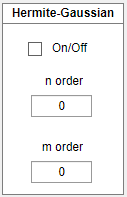Hermite-Gaussian beam

To generate an Hermite-Gaussian beam, the user has to specify two parameters: the vertical mode index m and the horizontal mode index n. Both parameters are crucial in Hermite-Gaussian equation [1]:
\(HG_{n,m} = \frac{1}{w_{0}}\mathbb{G}_{n}\left[\frac{\sqrt{2}\cdot x}{w_{0}}\right]\mathbb{G}_{m}\left[\frac{\sqrt{2}\cdot y}{w_{0}}\right]exp\left(\frac{-\rho^2}{w_{0}^2}\right)\),
where
\(\mathbb{G}_{n}(u)=\mathbb{H}_{n}exp\left( \frac{-u^2}{2} \right) \), \(n=0,1,2,...\)
\(\mathbb{G}_{m}(u)=\mathbb{H}_{m}exp\left( \frac{-u^2}{2} \right) \), \(m=0,1,2,...\).
The \(\mathbb{H}_{n}\) and \(\mathbb{H}_{m}\) are known as Hermite polynomial of order \(n,m\). An example below presents the amplitude map of Hermite-Gaussian beam: A) for the horizontal mode \(n=3\) and the vertical mode \(m=3\), B) \(n=5\) and \(m=2\).
